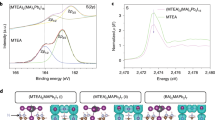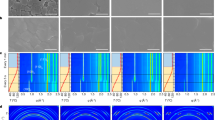Abstract
In the past few years, organic–inorganic halide perovskites have rapidly emerged as promising materials for photovoltaic applications, but simultaneously achieving high performance and long-term stability has proved challenging. Here, we show a one-step solution-processing strategy using phosphonic acid ammonium additives that results in efficient perovskite solar cells with enhanced stability. We modify the surface of methylammonium lead triiodide (CH3NH3PbI3) perovskite by spin-coating its precursor solution in the presence of butylphosphonic acid 4-ammonium chloride. Morphological, structural and elemental analyses show that the phosphonic acid ammonium additive acts as a crosslink between neighbouring grains in the perovskite structure, through strong hydrogen bonding of the –PO(OH)2 and –NH3+ terminal groups to the perovskite surface. The additives facilitate the incorporation of the perovskite within a mesoporous TiO2 scaffold, as well as the growth of a uniform perovskite layer at the surface, enhancing the material's photovoltaic performance from 8.8 to 16.7% as well as its resistance to moisture.
This is a preview of subscription content, access via your institution
Access options
Subscribe to this journal
Receive 12 print issues and online access
$259.00 per year
only $21.58 per issue
Buy this article
- Purchase on Springer Link
- Instant access to full article PDF
Prices may be subject to local taxes which are calculated during checkout





Similar content being viewed by others
References
Kojima, A., Teshima, K., Shirai, Y. & Miyasaka, T. Organometal halide perovskites as visible-light sensitizers for photovoltaic cells. J. Am. Chem. Soc. 131, 6050–6051 (2009).
Kim, H.-S. et al. Lead iodide perovskite sensitized all-solid-state submicron thin film mesoscopic solar cell with efficiency exceeding 9%. Sci. Rep. 2, 591 (2012).
Etgar, L. et al. Mesoscopic NH3NH3PbI3/TiO2 heterojunction solar cells. J. Am. Chem. Soc. 134, 17396–17399 (2012).
Lee, M. M., Teuscher, J., Miyasaka, T., Murakami, T. N. & Snaith, H. J. Efficient hybrid solar cells based on meso-superstructured organometal halide perovskites. Science 338, 643–647 (2012).
Hodes, G. Perovskite-based solar cells. Science 342, 317–318 (2013).
Burschka, J. et al. Sequential deposition as a route to high-performance perovskite-sensitized solar cells. Nature 499, 316–319 (2013).
Liu, M., Johnston, M. B. & Snaith, H. J. Efficient planar heterojunction perovskite solar cells by vapour deposition. Nature 501, 395–398 (2013).
Heo, J. H. et al. Efficient inorganic–organic hybrid heterojunction solar cells containing perovskite compound and polymeric hole conductors. Nature Photon. 7, 486–491 (2013).
Mei, A. et al. A hole-conductor-free, fully printable mesoscopic perovskite solar cell with high stability. Science 345, 295–298 (2014).
Zhou, H. et al. Interface engineering of highly efficient perovskite solar cells. Science 345, 542–546 (2014).
Jeon, N. J. et al. Solvent engineering for high-performance inorganic–organic hybrid perovskite solar cells. Nature Mater. 13, 897–903 (2014).
Im, J.-H. et al. Growth of CH3NH3PbI3 cuboids with controlled size for high-efficiency perovskite solar cells. Nature Nanotech. 9, 927–932 (2014).
Grätzel, M. Light and shade of perovskite solar cells. Nature Mater. 13, 838–842 (2014).
McGehee, M. D. Perovskite solar cells: continuing to soar. Nature Mater. 13, 845–846 (2014).
Malinkiewicz, O. Perovskite solar cells employing organic charge-transport layers. Nature Photon. 8, 128–132 (2014).
Chen, Q. et al. Planar heterojunction perovskite solar cells via vapor-assisted solution process. J. Am. Chem. Soc. 136, 622–625 (2014).
Xiao, M. et al. A fast deposition-crystallization procedure for highly efficient lead iodide perovskite thin-film solar cells. Angew. Chem. Int. Ed. 126, 9831–10120 (2014).
Dualeh, A. et al. Thermal behavior of methylammonium lead trihalide perovskite photovoltaic light harvesters. Chem. Mater. 26, 6160–6164 (2014).
Frost, J. M. et al. Atomistic origins of high-performance in hybrid halide perovskite solar cells. Nano Lett. 14, 2584–2590 (2014).
Pathak, S. K. et al. Performance and stability enhancement of dye-sensitized and perovskite solar cells by Al doping of TiO2 . Adv. Funct. Mater. 24, 6046–6055 (2014).
Chen, Q. et al. Controllable self-induced passivation of hybrid lead iodide perovskites toward high performance solar cells. Nano Lett. 14, 4158–4163 (2014).
Mercier, N. (HO2C(CH2)3NH3)2(CH3NH3)Pb2I7: a predicted noncentrosymmetrical structure built up from carboxylic acid supramolecular synthons and bilayer perovskite sheets. CrystEngComm 7, 429–432 (2005).
Li, Y., Zheng, G. & Lin, J. Synthesis, structure, and optical properties of a contorted 〈110〉-oriented layered hybrid perovskite: C3H11SN3PbBr4 . Eur. J. Inorg. Chem. 10, 1689–1692 (2008).
Chaudhuri, R. G. & Paria, S. Core/shell nanoparticles: classes, properties, synthesis mechanisms, characterization, and applications. Chem. Rev. 112, 2373–2433 (2012).
Liu, L. et al. Fully printable mesoscopic perovskite solar cells with organic silane self-assembled monolayer. J. Am. Chem. Soc. 137, 1790–1793 (2015).
Niu, G. et al. Study on the stability of CH3NH3PbI3 films and the effect of post-modification by aluminum oxide in all-solid-state hybrid solar cells. J. Mater. Chem. A 2, 705–710 (2014).
Dar, M. I. et al. Investigation regarding the role of chloride in organic–inorganic halide perovskites obtained from chloride containing precursors. Nano Lett. 14, 6991–6996 (2014).
Nanova, D. Unraveling the nanoscale morphologies of mesoporous perovskite solar cells and their correlation to device performance. Nano Lett. 14, 2735–2740 (2014).
Baikie, T. et al. Synthesis and crystal chemistry of the hybrid perovskite (CH3NH3)PbI3 for solid-state sensitized solar cell applications. J. Mater. Chem. A 1, 5628–5641 (2013).
Schmidt, L. C. et al. Nontemplate synthesis of CH3NH3PbBr3 perovskite nanoparticles. J. Am. Chem. Soc. 136, 850–853 (2014).
Eperon, G. E. et al. Morphological control for high performance, solution-processed planar heterojunction perovskite solar cells. Adv. Funct. Mater. 24, 151–157 (2014).
Leijtens, T. et al. The importance of perovskite pore filling in organometal mixed halide sensitized TiO2-based solar cells. J. Phys. Chem. Lett. 5, 1096–1102 (2014).
Conings, B. et al. Perovskite-based hybrid solar cells exceeding 10% efficiency with high reproducibility using a thin film sandwich approach. Adv. Mater. 26, 2041–2046 (2014).
Thompson, C. V. et al. Solid-state dewetting of thin films. Annu. Rev. Mater. Res. 42, 399–434 (2012).
Im, J.-H., Kim, H.-S. & Park, N.-G. Morphology–photovoltaic property correlation in perovskite solar cells: one-step versus two-step deposition of CH3NH3PbI3 . APL Mater. 2, 081510 (2014).
Dualeh, A. et al. Impedance spectroscopic analysis of lead iodide perovskite-sensitized solid-state solar cells. ACS Nano 8, 362–373 (2014).
Sanchez, R. S. et al. Slow dynamic processes in lead halide perovskite solar cells. Characteristic times and hysteresis. J. Phys. Chem. Lett. 5, 2357–2363 (2014).
Harms, H. A., Tétreault, N., Pellet, N., Bensimon, M. & Grätzel, M. Mesoscopic photosystems for solar light harvesting and conversion: facile and reversible transformation of metal-halide perovskites. Discuss. Faraday Soc. 176, 251–269 (2014).
Smith, I. C. et al. A layered hybrid perovskite solar-cell absorber with enhanced moisture stability. Angew. Chem. Int. Ed. 126, 11414–11417 (2014).
Im, J.-H. et al. 6.5% efficient perovskite quantum-dot-sensitized solar cell. Nanoscale 3, 4088–4093 (2011).
Kusama, H., Kurashige, M., Sayama, K., Yanagida, M. & Sugihara, H. Improved performance of black-dye-sensitized solar cells with nanocrystalline anatase TiO2 photoelectrodes prepared from TiCl4 and ammonium carbonate. J. Photochem. Photobiol. A 184, 163–169 (2006).
Acknowledgements
M.G. acknowledges support from the European Union Seventh Framework Program (grant agreement no. 309194 ‘GLOBASOL’). X.L., M.I.D., M.K.N. and M.G. acknowledge financial support from the Swiss CTI project (15864.2 PFNM-NM) and the European Community's Seventh Framework Programme (FP7/2007–2013) under grant agreement no. 281063 of the Powerweave project. H.H. acknowledges financial support from the National Natural Science Foundation of China (91433203, 61474049) and the Ministry of Science and Technology of China (863, SS2013AA50303, 2015AA034601).
Author information
Authors and Affiliations
Contributions
M.G. directed the scientific research for this work and assumed all correspondence with the editor and reviewers. M.G., H.H. and X.L. devised the idea for the project. X.L. and C.Y. designed the experiments, and fabricated and measured the devices. M.I.D. and J.L. carried out materials characterization. M.T. contributed to stability measurements. X.L. and M.I.D. wrote the initial draft of the manuscript. All authors contributed to the discussion and writing of the final paper.
Corresponding author
Ethics declarations
Competing interests
The authors declare no competing financial interests.
Supplementary information
Supplementary information
Supplementary information (PDF 2445 kb)
Rights and permissions
About this article
Cite this article
Li, X., Ibrahim Dar, M., Yi, C. et al. Improved performance and stability of perovskite solar cells by crystal crosslinking with alkylphosphonic acid ω-ammonium chlorides. Nature Chem 7, 703–711 (2015). https://doi.org/10.1038/nchem.2324
Received:
Accepted:
Published:
Issue Date:
DOI: https://doi.org/10.1038/nchem.2324
This article is cited by
-
Electron-withdrawing organic ligand for high-efficiency all-perovskite tandem solar cells
Nature Energy (2024)
-
Inverted perovskite solar cells using dimethylacridine-based dopants
Nature (2023)
-
One-stone-for-two-birds strategy to attain beyond 25% perovskite solar cells
Nature Communications (2023)
-
Terephthalic acid-driven organic–inorganic perovskite solar cells with enhanced humidity stability
Journal of Materials Science: Materials in Electronics (2023)
-
Kinetics and energetics of metal halide perovskite conversion reactions at the nanoscale
Communications Materials (2022)



